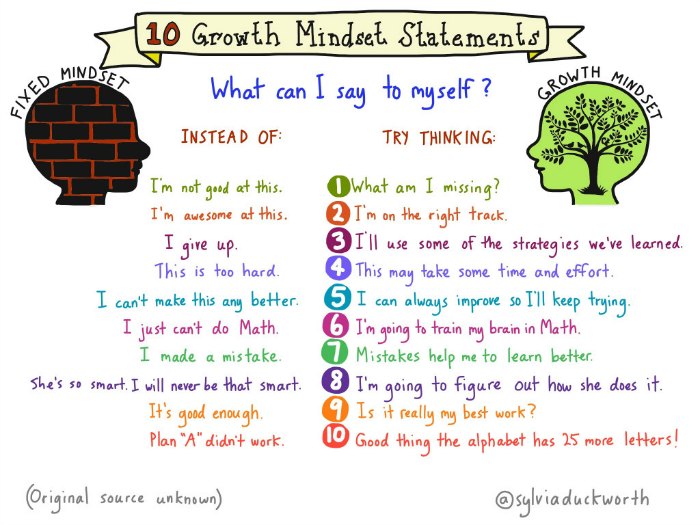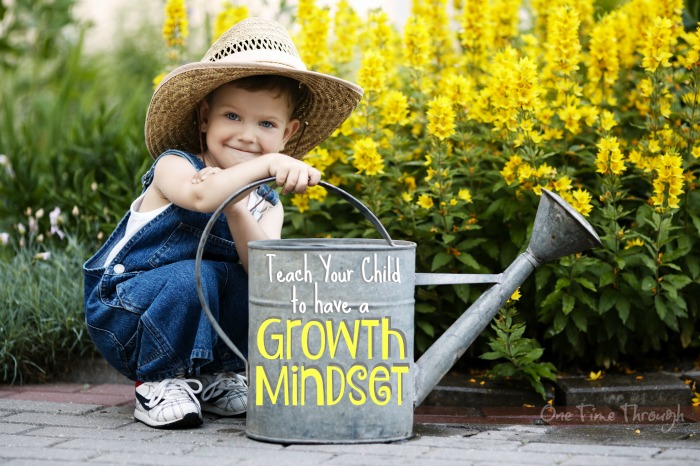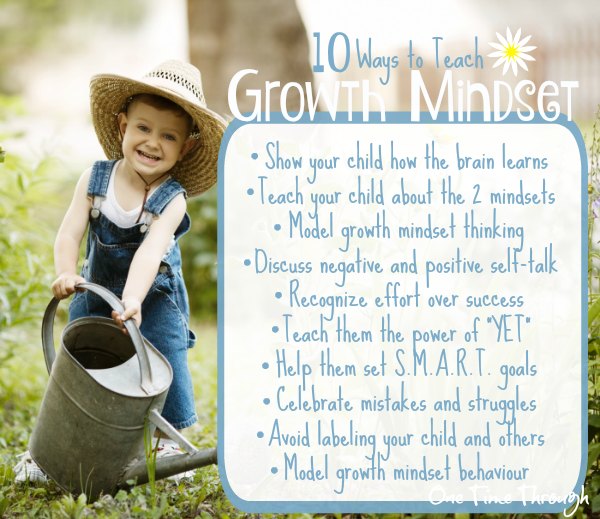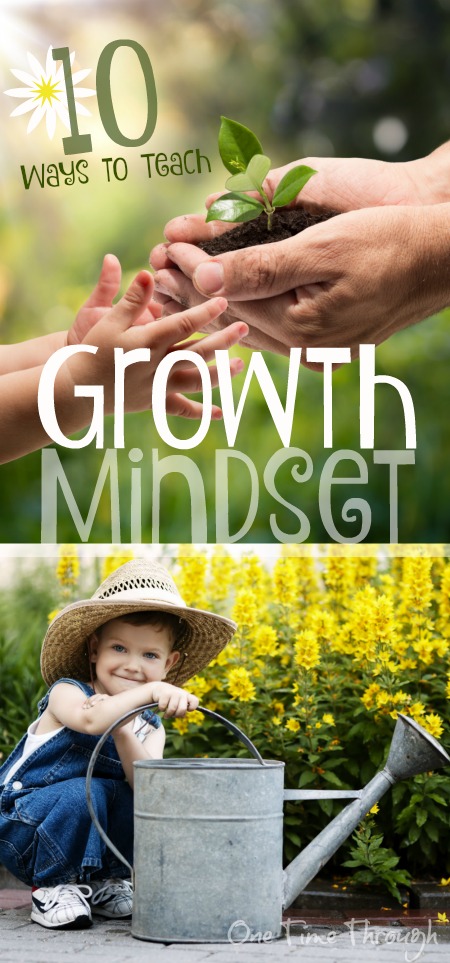Did you know that you can actually help your kids get smarter?
Today’s scientific brain research shows that by teaching kids about something called “Growth Mindset” – you can help them become better learners, become more persistent, and more intelligent and resilient overall!
This post breaks it all down for you. You’ll find 10 easy tips to teach your child to have a growth mindset and you’ll be well on your way to helping your child be the best person they can be!
Amazon affiliate links are included in this post. See my disclosure for more details.
The Parenting Scenario
I first became interested in learning about growth mindset when my 5 year old son Onetime started resisting practising piano.
Me: It’s time to practise your piano.
Onetime: (groans) I’m tired Mama.
Me: Your teacher expects you to practise everyday so you get better honey.
Onetime: Ughhh…can we do it later?
Me: (starting to groan inside too…) We need to do it now so we don’t run out of time before bedtime.
Every night it would be the same conversation…over and over…groan after groan.
I really need to figure this out, I thought, if he’s going to continue to take and enjoy music lessons – something I really value.
After wondering if learning about growth mindset might help, we had a little chat about how every time Onetime plays his piano scales, the neurons in his brain are growing more and more connections together.
Holding my hands towards each other and wiggling my fingers to show how the neurons reach for each other and connect up, I could see his eyes light up.
Once the connections are there, the scales and songs get much easier to play because the messages to your hands from your brain move faster and easier, I explained.
Although I’d like to say that Onetime began gleefully practising after our chat, I can’t. But he did give the scales a second go for the day and noticed himself that the second time was better than the first.
Next piano class, I even overheard him telling his piano teacher all about how neurons start to grow more connections the more he practises!
My son has a fixed mindset about a lot of things, and I figure it’s going to be a bit of a trek to help him develop a growth mindset. But knowing what I know about the power of mindsets, and their correlation with later success in life and happiness, I figure it’s worth my time to learn as much as I can about how to help him develop a positive mindset.
My Growth Mindset Research
In order to help my son, I started reading as much as I could about mindsets, and looking for resources to help teach him. And I found a goldmine of good stuff!
It’s taken me a while to gather these up for this post and my list continues to grow. I’ve done my best to distill the research out there into 10 simple guidelines to help guide kids to have a growth mindset.
For each tip, you’ll find strategies to teach it, as well as picture books and other resources that help reinforce the concept.
But before I share these 10 tips with you, you might want to take a few minutes to learn a bit about what having a growth mindset means and how it benefits children and parents.
Today’s post is the final in a mini-series of three posts. Although the posts can be read in any order, you might find that you understand more if you start from the beginning with: Growth Mindset for Parents 101 and then check out the Growth Mindset Self-Assessment.
Already up to speed on growth mindset? Read on!
10 Ways to Help Your Child Develop a Growth Mindset
1. Teach your child about the brain and how it learns
According to Dr. Dan Siegel, M.D. author of The Whole-Brain Child, kids start to develop a growth mindset just from learning about how their brain works and grows.
Once kids understand that the brain actually physically grows connections as they practise and learn new skills and concepts, they get excited about the learning process and feel less worried about making mistakes.
The more you use your brain the more brain you’ll have to use! ~Your Fantastic Elastic Brain
Your Fantastic Elastic Brain: Stretch It, Shape It by JoAnn Deak
Your Fantastic Elastic Brain explains in kid-friendly language what the brain is and how it works. It explains how connections between neurons strengthen the more we practise a skill and it helps kids understand how effort and persistence boost their intelligence! It has fun illustrations and will lead to lots of interesting discussions about growth mindset.
Other Helpful Books and Resources:
A Walk in the Rain with a Brain by Edward M. Hallowell – a kid-friendly tour of how the brain works and grows
The Whole-Brain Child: 12 Revolutionary Strategies to Nurture Your Child’s Developing Mind |
The Whole-Brain Child Workbook: Practical Exercises, Worksheets and Activities to Nurture Developing Minds by Dan Siegel
2. Teach your child about the different mindsets
If you want your kids to develop a growth mindset, self-awareness is a great place to start! I know I need to work on this myself.
You can start by teaching them to recognize the two different mindsets by reading them books or by watching a video.
After a few lessons at school about the basic differences between the two mindsets, all of my Kindies (4 and 5 year olds) could differentiate between examples of the two mindsets when discussing story characters.
I regularly hear my junior students (grade 4-6) point out fixed mindsets in each other, and my intermediate students (grades 7 and 8) can apply the terms to accurately describe the thinking and policies of Donald Trump! Ha!
Making A Splash – Growth Mindset for Kids by Carol E. Reiley
Making a Splash is a fun book that shows the differences in mindsets between two siblings learning to swim. This book has everything you need to explain growth mindset to your child.
It emphasizes effort and persistence in achieving success, and explains why some people have to work harder than others at certain skills. It even has a detailed section for parents that explains growth mindset and gives all kinds of suggestions for discussion with your child.
Other Helpful Books and Resources:
Mindset: The New Psychology of Success by Carol Dweck – Learn all about the two mindsets and how they impact the way we approach relationships, work and life!
3. Model growth mindset thinking
One of the best ways we can encourage our children to have a growth mindset is to work on developing one ourselves. After all, as developmental psychologists have known for a long time, kids learn much of their behaviour and attitudes from watching how we react to our challenges.
The easiest way to do this is to let your kids overhear you thinking aloud positive phrases when you make mistakes or find something difficult
Instead of… “I’m not very good at this.” or “This is too hard.”
Say… “This is really hard for me. I guess I better keep practising.”
Although it may feel a little awkward at first, the more you do it, the more natural it becomes and sounds.
This thinking aloud strategy is commonly used by teachers when modelling how to think while reading and you should notice eventually that your children will start to use these phrases themselves.
I Knew You Could: A Book for All the Stops in Your Life by Craig Dorfman
I’m in love with this modern sequel to The Little Engine That Could. I’ve given this book as a gift to students graduating from highschool and university as well as read it to my school-aged students.
It documents the little engine’s travels through the difficult and challenging journey of life. He meets obstacles with a positive attitude and learns that his attitude often determines how things turn out.
Other Helpful Books and Resources:
Thanks for the Feedback, I Think by Julia Cook –
Help your kids understand that constructive feedback after mistakes or failures can help them improve and get smarter!
Everyone Can Learn to Ride a Bicycle by Chris Raschka – This is such an encouraging book for any child struggling with learning to ride a bicycle, or any other skill.
4. Discuss negative and positive self-talk
Talk to your kids about their “inner voice” and how it sometimes tells them things that aren’t always helpful. Teach them to challenge those negative inner statements with more positive alternatives.
Sylvia Duckworth, my favourite sketch-noter, and a fellow Canadian, created this fantastic sketch-note which should give you some ideas of where to start.

Bubble Gum Brain by Julia Cook
This hilarious book likens having a growth mindset to having a brain made of bubble gum that grows and constantly learns and stretches. It tells the funny story of two boys trying to learn how to ride a unicycle. The one boy has bubble gum brain and the other has “brick brain” – or a fixed mindset.
The book shows the different kinds of self-talk that kids with both mindsets tend to have and it teaches how having a growth mindset encourages perseverance and success.
Other Helpful Books and Resources:
The Little Engine That Could by Watty Piper
This classic story has been around for generations because of its timeless message that a positive attitude and effort is more important to your success than your talents.
You’ll be joining your child chanting “I think I can, I think I can!” by the end of this one.
My Day Is Ruined!: A Story Teaching Flexible Thinking by Bryan Smith
The Dot by Peter H. Reynolds
Ish by Peter H. Reynolds
Good News, Bad News by Jeff Mack
5. Recognize effort over success
Instead of focusing your attention on the times when your child is successful, recognize the times when they are putting effort into what they are doing.
After all, no one can control whether they are successful or not. All they can do is try.
So if you recognize your child’s efforts, win or lose, they will come to understand that what is important is their effort.
This kind of recognition promotes an internal sense of self-efficacy.
In other words, your child will come to believe that her successes are due to her level of effort (which she can control), rather than an innate level of talent or skill (that she can’t control).
Additionally, recognizing effort is not just helpful for kids who struggle. It is also helpful for kids who achieve success easily because it pushes them to continue challenging themselves.
Sometimes You Win–Sometimes You Learn for Kids by John C. Maxwell

A great book to start conversations about the importance of failures.
Winning takes effort, this much you will see. What you learn from your loss can bring victory!
Other Helpful Books and Resources:
6. Teach them the power of “YET”
I can’t tie my shoes.
I can’t ride a bike.
I can’t read.
Have you heard these words, or something similar?
It can be heartbreaking to hear your child say these things. And it’s almost guaranteed that they are feeling frustrated, sad and hopeless when they say them.
Why not next time you hear such a phrase, add on the word “YET” to the end of their sentence. And point it out to the child.
Just feel the difference…
I can’t tie my shoes YET.
I can’t ride a bike YET.
I can’t read YET.
It’s more hopeful, more optimistic, and so much more encouraging.
Teach your child to add the magical power of YET to their thoughts and words!
When Pigs Fly by Valerie Coulman
An adorable story about a cow named Ralph who wants his Dad to buy him a bicycle. The father cow tells him that he’ll buy Ralph a bicycle when pigs fly. From there on, Ralph endeavors to find a way to help pigs fly.
Along the way, he models the power of YET and shows that with a little creative thinking, and a lot of persistence, any obstacle can be overcome!
This book can be difficult to find in print, but there is a great little video of it here you can watch.
Other Helpful Books and Resources:
A fun Power of “YET” poster from Creative Access.
Another free Yet poster from Danielle Murphy.
7. Help them set goals
Helping your child set goals for himself, and then guiding him through the process of achieving those goals, helps boost his ability to see himself as capable of continual improvement and learning.
According to Carol Dweck, it’s important that when we set goals we come up with a specific plan to improve.
Have you heard of a S.M.A.R.T. goal? Basically, this is an acronym for helping to set meaningful goals. All goals should have all of the following components.
- S = Specific – Who? What? Where? When will I work on this?
- M= Measurable – How will we know if we succeed?
- A = Achievable – Is this realistic? Can this be done? Do I have only 1 or 2 goals to focus on?
- R = Relevant – How will this help me? Can I see the benefits of achieving this goal?
- T = Timely – When do I want to be able to do this by?
To do some goal-setting with your child, start by having your child brainstorm and record all the things they do well, and then brainstorm things they want to get better at.
You can then help your child come up with a plan for achieving their goals, ensuring that it is achievable by breaking it down into manageable steps.
When your child has decided on their goal, why not invite them to record it on this free goal-setting printable created by the Crazy for First Grade blog.
Someday by Eileen Spinelli

Someday provides a great place to start talking with your child about his or her dreams and what they can start doing now to move towards those goals!
Other Helpful Books and Resources:
Today I Will: A Year of Quotes, Notes, and Promises to Myself by Eileen and Jerry Spinelli
How to Teach Kids Perseverance and Goal-Setting – fantastic article at Parents.com
8. Celebrate mistakes and struggles
Allow your kids to fail and make mistakes.
But, isn’t that hard to do? And why would you want to do that if you can help them succeed?
Because making mistakes is how we learn.
Instead of teaching our kids to fear mistakes, why not teach them to celebrate mistakes?
- At the end of the school day, ask about what was difficult today, or what they worked hard on.
- At dinnertime, ask each person at the table to share a mistake they made today and what they learned from it.
- After a failure, talk about what they would do differently next time to improve.
Rosie Revere, Engineer by Andrea Beaty

I love how Great Aunt Rose cheers Rosie on by saying, “Your brilliant first flop was a raging success. C’mon let’s get busy and on to the next.”
Other Helpful Books and Resources:
Mistakes That Worked: 40 Familiar Inventions & How They Came to Be by Charlotte Foltz Jones
Beautiful Oops! by Barney Saltzberg
It’s Okay to Make Mistakes by Todd Parr
Watch this video on celebrating mistakes with kids by Positive Parenting Solutions.
Read about this parenting technique that supports kids when they’re struggling.
9. Avoid labeling your child and others
Whether it’s a good label (You are so smart!) or a negative one (Don’t be such a lazy bones!), when we label our kids, we are placing them in a figurative box that outlines how they are supposed to be.
Instead of motivating kids, both positive and negative labels communicate a fixed mindset.
If we want our kids to understand that they can continually grow, change and improve, we want them to believe that regardless of their innate talents, their success depends on the amount of effort and time they put in.
The Girl Who Never Made Mistakes by Mark Pett and Gary Rubinstein

This story teaches the reader that it’s okay to make mistakes, and the importance of not taking yourself too seriously.
Other Helpful Books and Resources:
Discipline Without Distress: 135 tools for raising caring, responsible children without time-out, spanking, punishment or bribery by Judy Arnall
Read about Self-Esteem and the dangers of labelling children, both good and bad.
10. Model growth mindset behaviour
Let your kids see you…
- Persisting with difficult tasks
- Trying to learn something new
- Taking on challenges with enthusiasm
- Making mistakes and persisting
- Meeting failures with renewed effort to succeed
Sky Pig by Jan. L. Coates

It’s perfect for talking about persistence, and the importance of having a positive attitude towards failure. I also love the gorgeous illustrations which are a mix of plasticine and paper collage elements!
Other Helpful Books and Resources:
What Do You Do With a Problem? by Kobi Yamada
The Most Magnificent Thing by Ashley Spires
Sam and Dave Dig a Hole by Mac Barnett
Going Places by Peter and Paul Reynolds
Ryan The Spy and: The Inventor’s Secret: A Growth Mindset Series by Jason Rago
That’s it for my tips and recommendations to help a child develop a growth mindset. If you have any other ideas – I would truly love to hear them. Leave me a comment below!
Find even more ideas and resources on my Growth Mindset Parenting Pinterest board!
Keep on growing!


























What a fantastic post! I can’t wait to dig into this more. I use this language in my classroom and have started to use it at home too. I can not wait to explore more of the resources you’ve gathered.
Glad that you found it helpful Kate. I think it’s so important to teach kids about mindset – because it can impact them for the rest of their lives. I wish I’d learned about this when I was younger. Thanks for dropping by! Sue
As an educator I see how shifting student mindsets is instrumental in transformative change. For teachers out there, I’ve re-focused this learning resources for teenagers in a free lesson pack: https://www.teacherspayteachers.com/Product/FREE-Growth-Mindset-Lesson-Pack-3366121
Fantastic post! Very helpful. My son and I have read many of these books over the past few years. I can’t wait to reread them with him and situate them in our larger conversation about persistence and mindset.
Thanks so much Melissa. Glad you found this helpful!
Thank you for this, I have a 2 year old and another on the way I just finished Carol Dweck’s book Mind Set. I am excited about modeling a growth mindset in my own life for my children to see and practice speech that will cultivated that in their own thinking.
Thanks so much for dropping by Katie. I’m glad you found this helpful. I really loved Carol’s book and wish I had read it when mine was much younger. Best of luck with the new baby!